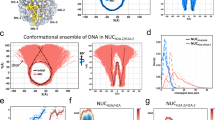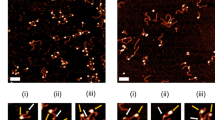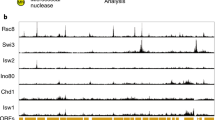Abstract
Although it is believed that the interconversion between permissive and refractory chromatin structures is important in regulating gene transcription, this process is poorly understood. Central to addressing this issue is to elucidate how a nucleosomal array folds into higher-order chromatin structures. Such findings can then provide new insights into how the folding process is regulated to yield different functional states. Using well-defined in vitro chromatin-assembly and transcription systems, we show that a small acidic region on the surface of the nucleosome is crucial both for the folding of a nucleosomal template into the 30-nm chromatin fiber and for the efficient repression of transcription, thereby providing a mechanistic link between these two essential processes. This structure-function relationship has been exploited by complex eukaryotic cells through the replacement of H2A with the specific variant H2A.Bbd, which naturally lacks an acidic patch.
This is a preview of subscription content, access via your institution
Access options
Subscribe to this journal
Receive 12 print issues and online access
$189.00 per year
only $15.75 per issue
Buy this article
- Purchase on Springer Link
- Instant access to full article PDF
Prices may be subject to local taxes which are calculated during checkout




Similar content being viewed by others
References
Tremethick, D.J. Higher-order structures of chromatin: the elusive 30 nm fiber. Cell 128, 651–654 (2007).
Steger, D.J. & Workman, J.L. Remodeling chromatin structures for transcription: what happens to the histones? Bioessays 18, 875–884 (1996).
Eberharter, A. & Becker, P.B. Histone acetylation: a switch between repressive and permissive chromatin. Second in review series on chromatin dynamics. EMBO Rep. 3, 224–229 (2002).
Kornberg, R.D. & Lorch, Y. Chromatin and transcription: where do we go from here. Curr. Opin. Genet. Dev. 12, 249–251 (2002).
Taylor, I.C., Workman, J.L., Schuetz, T.J. & Kingston, R.E. Facilitated binding of GAL4 and heat shock factor to nucleosomal templates: differential function of DNA-binding domains. Genes Dev. 5, 1285–1298 (1991).
Tse, C., Sera, T., Wolffe, A.P. & Hansen, J.C. Disruption of higher-order folding by core histone acetylation dramatically enhances transcription of nucleosomal arrays by RNA polymerase III. Mol. Cell. Biol. 18, 4629–4638 (1998).
Peterson, C.L. & Laniel, M.A. Histones and histone modifications. Curr. Biol. 14, R546–R551 (2004).
Luger, K., Mader, A.W., Richmond, R.K., Sargent, D.F. & Richmond, T.J. Crystal structure of the nucleosome core particle at 2.8 Å resolution. Nature 389, 251–260 (1997).
Dorigo, B. et al. Nucleosome arrays reveal the two-start organization of the chromatin fiber. Science 306, 1571–1573 (2004).
Dorigo, B., Schalch, T., Bystricky, K. & Richmond, T.J. Chromatin fiber folding: requirement for the histone H4 N-terminal tail. J. Mol. Biol. 327, 85–96 (2003).
Fan, J.Y., Rangasamy, D., Luger, K. & Tremethick, D.J. H2A.Z alters the nucleosome surface to promote HP1α-mediated chromatin fiber folding. Mol. Cell 16, 655–661 (2004).
Shogren-Knaak, M. et al. Histone H4–K16 acetylation controls chromatin structure and protein interactions. Science 311, 844–847 (2006).
Greaves, I.K., Rangasamy, D., Ridgway, P. & Tremethick, D.J. H2A.Z contributes to the unique 3D structure of the centromere. Proc. Natl. Acad. Sci. USA 104, 525–530 (2007).
Chadwick, B.P. & Willard, H.F. A novel chromatin protein, distantly related to histone H2A, is largely excluded from the inactive X chromosome. J. Cell Biol. 152, 375–384 (2001).
Bao, Y. et al. Nucleosomes containing the histone variant H2A.Bbd organize only 118 base pairs of DNA. EMBO J. 23, 3314–3324 (2004).
Doyen, C.M. et al. Dissection of the unusual structural and functional properties of the variant H2A.Bbd nucleosome. EMBO J. 25, 4234–4244 (2006).
Fan, J.Y., Gordon, F., Luger, K., Hansen, J.C. & Tremethick, D.J. The essential histone variant H2A.Z regulates the equilibrium between different chromatin conformational states. Nat. Struct. Biol. 9, 172–176 (2002).
Woodcock, C.L. & Dimitrov, S. Higher-order structure of chromatin and chromosomes. Curr. Opin. Genet. Dev. 11, 130–135 (2001).
Fletcher, T.M. & Hansen, J.C. The nucleosomal array: structure/function relationships. Crit. Rev. Eukaryot. Gene Expr. 6, 149–188 (1996).
Horn, P.J., Crowley, K.A., Carruthers, L.M., Hansen, J.C. & Peterson, C.L. The SIN domain of the histone octamer is essential for intramolecular folding of nucleosomal arrays. Nat. Struct. Biol. 9, 167–171 (2002).
Steger, D.J., Eberharter, A., John, S., Grant, P.A. & Workman, J.L. Purified histone acetyltransferase complexes stimulate HIV-1 transcription from preassembled nucleosomal arrays. Proc. Natl. Acad. Sci. USA 95, 12924–12929 (1998).
Caravaca, J.M., Cano, S., Gallego, I. & Daban, J.R. Structural elements of bulk chromatin within metaphase chromosomes. Chromosome Res. 13, 725–743 (2005).
Daban, J.R. & Bermudez, A. Interdigitated solenoid model for compact chromatin fibers. Biochemistry 37, 4299–4304 (1998).
Horowitz-Scherer, R.A. & Woodcock, C.L. Organization of interphase chromatin. Chromosoma 115, 1–14 (2006).
Greaves, I.K., Rangasamy, D., Devoy, M., Marshall Graves, J.A. & Tremethick, D.J. The X and Y chromosomes assemble into H2A.Z-containing [corrected] facultative heterochromatin [corrected] following meiosis. Mol. Cell. Biol. 26, 5394–5405 (2006).
Su, A.I. et al. Large-scale analysis of the human and mouse transcriptomes. Proc. Natl. Acad. Sci. USA 99, 4465–4470 (2002).
Strick, R., Strissel, P.L., Gavrilov, K. & Levi-Setti, R. Cation-chromatin binding as shown by ion microscopy is essential for the structural integrity of chromosomes. J. Cell Biol. 155, 899–910 (2001).
Belmont, A.S. & Bruce, K. Visualization of G1 chromosomes: a folded, twisted, supercoiled chromonema model of interphase chromatid structure. J. Cell Biol. 127, 287–302 (1994).
Luger, K., Rechsteiner, T.J. & Richmond, T.J. Preparation of nucleosome core particle from recombinant histones. Methods Enzymol. 304, 3–19 (1999).
Carruthers, L.M., Tse, C., Walker, K.P., III & Hansen, J.C. Assembly of defined nucleosomal and chromatin arrays from pure components. Methods Enzymol. 304, 19–35 (1999).
Acknowledgements
We especially thank K. Luger (Colorado State University, Fort Collins) for providing recombinant histones and sharing unpublished data and for many helpful discussions, Y. Bao (Colorado State University, Fort Collins) for recombinant H2A.Bbd, J. Hansen (Colorado State University, Fort Collins) for continued support and critical reading of this manuscript, and T. Soboleva (The John Curtin School of Medical Research) for analysis of published gene expression array data. We also thank D. Rhodes (Medical Research Council Laboratory of Molecular Biology) for the 601-200-12 DNA template and J. Workman (Stowers Institute for Medical Research) for the HIV-208-5S DNA template. This work was supported by an Australian Research grant to J.Y.F. and D.J.T.
Author information
Authors and Affiliations
Contributions
J.Z. and J.Y.F. carried out the research, D.R. generated mutant histone clones, and D.J.T. devised the project and wrote the paper.
Corresponding author
Supplementary information
Supplementary Text and Figures
Supplementary Figures 1–4, Supplementary Table 1 (PDF 1063 kb)
Rights and permissions
About this article
Cite this article
Zhou, J., Fan, J., Rangasamy, D. et al. The nucleosome surface regulates chromatin compaction and couples it with transcriptional repression. Nat Struct Mol Biol 14, 1070–1076 (2007). https://doi.org/10.1038/nsmb1323
Received:
Accepted:
Published:
Issue Date:
DOI: https://doi.org/10.1038/nsmb1323
This article is cited by
-
Interplay between coding and non-coding regulation drives the Arabidopsis seed-to-seedling transition
Nature Communications (2024)
-
Diversity of chromatin condensation patterns, nuclear reorganization, evolution and phylogenetic distribution of sperm nuclear basic proteins in fish
Reviews in Fish Biology and Fisheries (2022)
-
The solid and liquid states of chromatin
Epigenetics & Chromatin (2021)
-
Multiple roles of H2A.Z in regulating promoter chromatin architecture in human cells
Nature Communications (2021)
-
Molecular mechanism of histone variant H2A.B on stability and assembly of nucleosome and chromatin structures
Epigenetics & Chromatin (2020)



